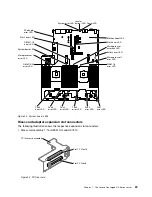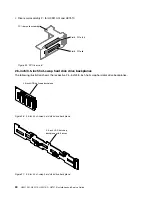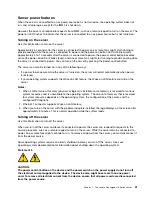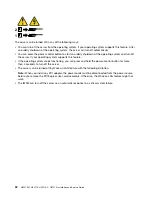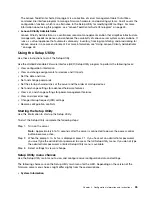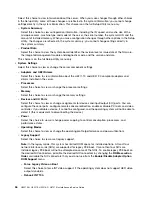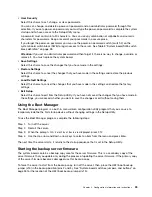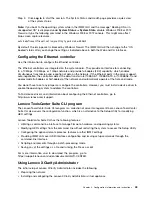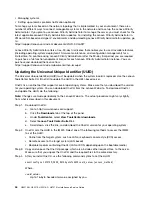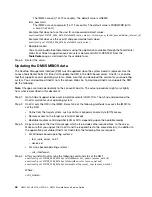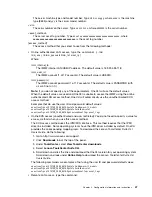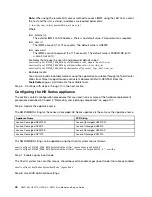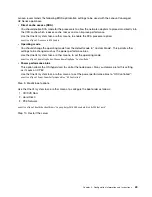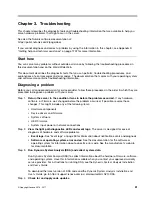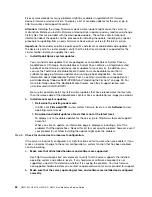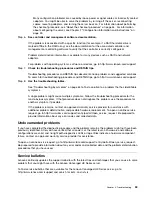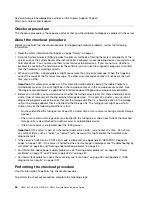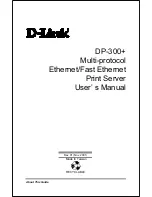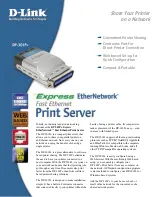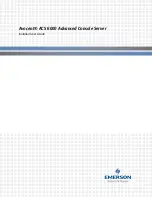
• Power/reset control (power-on, hard and soft shutdown, hard and soft reset, schedule power control).
• Query power-supply input power.
• ROM-based IMM firmware flash updates.
• Serial over LAN (SOL).
• Serial port redirection over telnet or ssh.
• SMI handling
• System event log (SEL) - user readable event log.
The IMM also provides the following remote server management capabilities through the ipmitool, a
management utility program:
•
Command-line interface (IPMI Shell)
The command-line interface provides direct access to server management functions through the IPMI
2.0 protocol. Use the command-line interface to issue commands to control the server power, view
system information, and identify the server. You can also save one or more commands as a text file and
run the file as a script.
•
Serial over LAN
Establish a Serial over LAN (SOL) connection to manage servers from a remote location. You can remotely
view and change the UEFI settings, restart the server, identify the server, and perform other management
functions. Any standard Telnet client application can access the SOL connection.
For more information about IMM, see the
Integrated Management Module II User's Guide
at
Using the remote presence and blue-screen capture features
The remote presence and blue-screen capture features are integrated functions of the IMM2.
The remote presence feature provides the following functions:
• Remotely viewing video with graphics resolutions up to 1600 x 1200 at 75 Hz, regardless of the system
state
• Remotely accessing the server, using the keyboard and mouse from a remote client
• Uploading a diskette image to the IMM memory and mapping it to the server as a virtual drive
The blue-screen capture feature captures the video display contents before the IMM restarts the server when
the IMM detects an operating-system hang condition. A system administrator can use the blue-screen
capture to assist in determining the cause of the hang condition.
Obtaining the IMM host name
Use this information to obtain the IMM host name.
If you are logging on to the IMM for the first time after installation, the IMM defaults to DHCP. If a DHCP
server is not available, the IMM uses a static IP address of 192.168.70.125. The default IPv4 host name
is “IMM-” (plus the last 12 characters on the IMM MAC address). The default host name also comes on
the IMM network access tag that comes attached to the power supply on the rear of the server. The IMM
network access tag provides the default host name of the IMM and does not require you to start the server.
The IPv6 link-local address (LLA) is derived from the IMM default host name. The IMM LLA is on the IMM
network access tag is on the power supply on the rear of the server. To derive the link-local address,
complete the following steps:
Configuration information and instructions
41
Summary of Contents for HX3510-G
Page 1: ...HX3510 G HX5510 HX5510 C HX7510 Installation and Service Guide Machine Type 8695 ...
Page 6: ...iv HX3510 G HX5510 HX5510 C HX7510 Installation and Service Guide ...
Page 62: ...50 HX3510 G HX5510 HX5510 C HX7510 Installation and Service Guide ...
Page 102: ...90 HX3510 G HX5510 HX5510 C HX7510 Installation and Service Guide ...
Page 112: ...100 HX3510 G HX5510 HX5510 C HX7510 Installation and Service Guide ...
Page 1222: ...1210 HX3510 G HX5510 HX5510 C HX7510 Installation and Service Guide ...
Page 1238: ...1226 HX3510 G HX5510 HX5510 C HX7510 Installation and Service Guide ...
Page 1239: ......
Page 1240: ......



